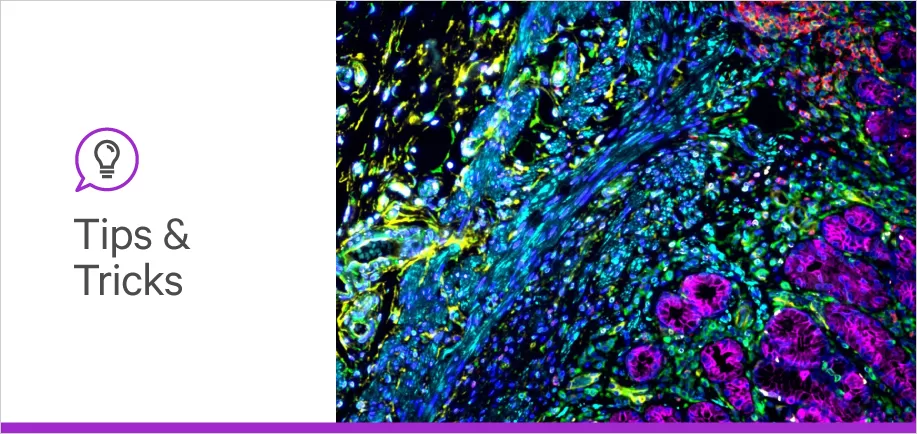
Menu

Immunohistochemistry (IHC) micrographs often look like fine art pieces—intricate structures stained with vibrant, contrasting colors. You might have generated one of those images in the past and feel very proud of it. As a life science researcher, you probably don’t think about color hue, brightness, and saturation when planning an experiment. That doesn’t mean that identifying the proper IHC substrates—a critical decision when developing an assay—is an easy task.
IHC substrates are available in many different types and colors, and your decision involves knowledge of specific technical factors. When it comes to selecting the substrate for your IHC application, you have variety and flexibility, and our focus is to help you make the right decision. This blog will discuss different factors to consider—enzyme, sensitivity, color, method of visualization, and stability—when selecting the appropriate substrate (and, consequently, color) for your experiment.

IHC detection systems usually include two different enzymes—horseradish peroxidase (HRP) and alkaline (AP)—and this is the first factor to consider when selecting an IHC substrate. HRP-based detection systems generate sharp and dense precipitates. Applications that require detection of intracellular targets or highly delineated locations frequently benefit from the use of HRP-based detection systems. Conversely, AP-based detection systems are the preferred choice for applications that require visualization of underlying tissue structure, as their precipitates are diffuse and translucent.
You should also be aware that substrates are enzyme-specific; an HRP substrate will not react with an AP-based detection system and vice versa. This specificity brings additional flexibility to your experiments as it allows for multiple staining applications and may help circumvent problems with endogenous enzyme activity by simply changing the enzyme detection system.
When choosing the substrate color, the first factor to consider is the need for contrast between the target and the tissue specimen. Some tissues, such as melanoma, are naturally pigmented or have brown or black tissue deposits. Using a substrate that has an excellent contrast is imperative to avoid false-positive interpretations in these situations. You should also consider the color of any counterstain that will be used.
Contrast is also essential when doing double-staining. For example, if you select a red substrate for one antigen, you may want to choose a blue substrate for the other target. However, be aware that some substrates, despite their contrasting colors, are simply not compatible or must be applied in a specific order in the multiplex workflow—Vector Blue is compatible with Vector Red when Vector Blue is used for the first antigen label.
For a complete guide to compatibility between enzyme substrates, please refer to our IHC Multiplexing Guide.
Different substrates vary in their sensitivity, which offers additional flexibility and control when designing experiments. Higher sensitivity allows better detection of low abundance proteins. Different formulations of the same substrate also have varying sensitivity. For maximum sensitivity, ImmPACT substrates should be chosen over other substrate formulations offer by Vector Laboratories.
Choosing enzyme substrates with high sensitivity also has the potential to reduce costs in the long run. The figure below shows that an eight fold increase in the primary antibody dilution still yields an appropriate staining intensity. Some substrates have the added benefit of increased sensitivity with longer incubation times. The AP substrate BCIP/NBT, for example, offers an incubation time of up to 24 hours.

ImmPACT DAB, one of the most sensitive Vector Laboratories substrates, yields appropriate staining intensity even with an 8-fold dilution of the primary antibody.
While all enzyme substrates are compatible with brightfield microscopes, depending on your visualization method, your options may be less abundant. Spectral imaging offers variety and flexibility, as Vector Black is the only substrate incompatible with this imaging technique. When using dark field and electron microscopy, you can still choose from a good 10 different options of HRP substrates. Fluorescence microscopy is the method with the least number of options available—four AP substrates.
Some immunostaining applications may require heating the specimen as one of the steps in the protocol. For example, heating may be necessary for antigen retrieval in IHC or DNA denaturation in in situ hybridization. When following protocols that require specimen heating, always use the heat-resistant substrate first. Vector Laboratories offers three HRP- and four AP-based substrates to assist you with those applications.
After identifying and meeting the technical requirements of your particular IHC application, you may still have the option to choose from a few different color tones. This is your opportunity to add a personal touch and opt for your favorite color. After all, you may feel so proud of your micrograph that you end up framing and hanging it on a wall.
Vector Laboratories offer a total of 18 substrate kits for IHC applications—13 for HRP- and 5 for AP-based systems. Such variety equals a total of 9 color tones for single antigen staining and 42 combinations for double staining applications. Choosing from many different options is challenging, but considering your specific needs—enzyme, color sensitivity, visualization, and heat resistance—will help you nail down and select the most appropriate options.
Be sure to check our IHC Resource Guide or contact our Technical Support if you need additional help.
Happy Staining!





Stay in the Loop
Join Our Online Community
The latest news, tips, and product releases delivered conveniently to your inbox.
We’re social scientists! Let’s connect.
Together we breakthroughTM

©Vector Laboratories, Inc. 2023 All Rights Reserved.